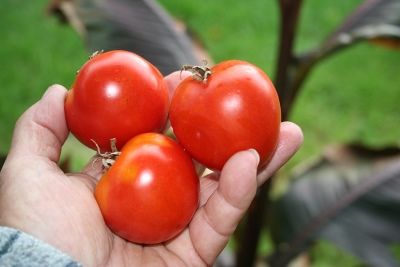
- Authors: Mashtakov A.A., Mashtakova A.Kh., Strelnikova T.R., Mashtakov N.A.
- Year of approval: 2005
- Category: hybrid
- Growth type: determinant
- Appointment: fresh consumption
- Ripening period: early
- Ripening time, days: 79-108
- Growing conditions: for open ground
- Transportability: Yes
- Marketable fruit yield,%: up to 99%
Among the universal early ripening tomatoes, many gardeners note the Irishka hybrid (synonym Irishka F1), which is resistant to major diseases, has a classic tomato flavor, a high market yield (99%) and excellent transportability. This parameter, as well as unpretentiousness, make it possible to use the hybrid for cultivation on farms. Irishka is grown in warm regions in the open field. The fruits can be eaten fresh, for making salads and sandwiches, they are used in cooking as excellent companions for the first and second courses. Some owners recycle surplus crops to make juices and sauces.
Breeding history
The culture was approved for use in 2005, the authors are A. A. Mashtakova, A. Kh. Mashtakova, N. A. Mashtakov, T. R. Strelnikova.
Description of the variety
Low (70-80 cm) sprawling bushes are covered with medium-sized green sparse foliage. Flowers form in intermediate inflorescences, on which an ovary is formed in the amount of 6-8 berries, which are attached to the articulated stalk.
Hybrid advantages:
yield;
unpretentiousness;
versatility;
early maturity and keeping quality;
marketability, transportability.
Disadvantages:
the need for pinching;
weak resistance to late blight.
The first inflorescence is formed after 5-6 leaves, all subsequent ones after 1-2 leaf cuttings.
The main qualities of the fruit
Fruits are round, medium-sized (from 58 to 101 g), colored in a green palette when unripe. At the stage of full ripeness, they change color to bright red. Lined low-ribbed tomatoes look very decorative and attractive, which arouses genuine interest of buyers.
Taste characteristics
The pulp is firm, fleshy, has a sweet taste with moderate acidity. The amount of dry matter within 3.6%
Ripening and fruiting
Belongs to the category of early ripening, ripening periods from 79 days allow us to rightfully call it ultra-ripe. Harvested in July-August.
Yield
Irishka gives excellent yield indicators while observing agrotechnical requirements. Up to 3 kg of fruits can be harvested from one bush, taking into account the compactness of the plant and the permissible planting density, from one square meter. meters are harvested up to 15-17 kg and up to 219-567 centners per hectare.
The timing of planting seedlings and planting in the ground
Seeds for seedlings are sown 3 months before planting in the ground. Approximate dates are sowing from March 20 to April 10, disembarkation to a permanent place from May 15 to early summer.

Growing tomato seedlings is an extremely important process, because it largely depends on whether the gardener will be able to harvest at all. All aspects must be taken into account, from seedbed preparation to planting in the ground.
Landing scheme
The proposed planting scheme is 30x70 cm, however, the shape of the bush allows them to significantly compact without the slightest damage - up to 6 roots per sq. m.

Growing and care
Tomato is grown in a traditional seedling way, although its early maturity allows you to sow seeds directly into the garden. However, at the same time, the timing of fruiting will significantly shift, and the harvest will be obtained simultaneously with the middle late category. The soil for tomato should be fertile, loose, breathable, with a neutral acidity level. Acidic earths are deoxidized with bone, dolomite meal. Dense heavy soil is loosened in several ways:
sowing green manure;
using humus or compost;
the introduction of buckwheat or other husk into the soil.
Buckwheat husk not only improves the structure, but also enriches the composition of the soil, filling it with vitamins, minerals, attracting earthworms.
For tomatoes, they begin to cook the place in the fall, adding organic matter for digging. In the spring, the ridges are enriched with humus, mineral fertilizers, and ash. The small height of the bushes does not mean that they do not need support. The stems do not withstand a good harvest and lie down. Therefore, stakes are installed near each root. Planted young plants need protection from the sun, even if hardening measures have been taken beforehand.
Further care of the hybrid: timely watering, weeding, feeding and pinching. This will avoid thickening. During a set of vegetative mass, tomatoes are fed with nitrogen, during the budding period - with phosphorus-potassium fertilizers.




A plant needs different micronutrients at each stage of growth. All fertilizers can be divided into two groups: mineral and organic. Folk remedies are often used: iodine, yeast, bird droppings, eggshells.
It is important to observe the rate and period of feeding. This also applies to folk remedies and organic fertilizers.
Disease and pest resistance
The hybrid is highly resistant to diseases such as Alternaria and TMV. However, it grows in open spaces, which means the possibility of late blight with persistent precipitation. Pests are dangerous for tomato:
aphid;
thrips;
nematode;
bear, wireworm;
May and Colorado beetles.
In order to prevent the appearance of diseases and pests, prophylaxis with solutions of insecticides and fungicides is necessary.


Resistant to adverse weather conditions
Irishka is considered drought-, cold- and heat-resistant tomato.
Growing regions
The Irishka hybrid is recommended for cultivation in the southern regions, as well as in the middle lane, the Volga region, the Central Black Sea region and in the North Caucasus.

























































































